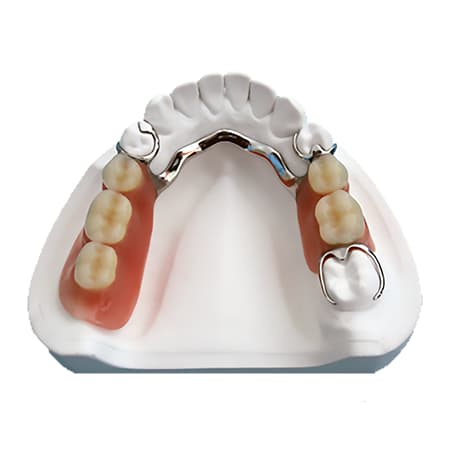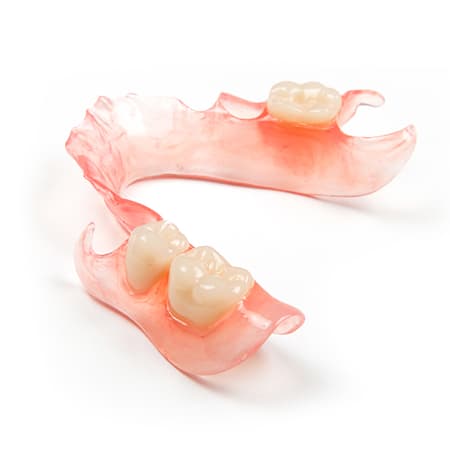
Partial Dentures Range
Confidentures offers a diverse collection of handcrafted and customised dentures to serve a variety of budgets and needs. Choose one of the options below to learn more, including full dentures, partial dentures, and more.
How Partial Dentures Work
Partial dentures are removable devices made to fill the gaps left by missing teeth, helping to improve both oral health and overall functionality. They help you chew, speak clearly, and smile with confidence. These dentures have a gum-colored base that holds the artificial teeth, and they are kept in place with small clasps or attachments that fit around your natural teeth. A mold of your mouth is taken to ensure they fit just right. They also help keep your remaining teeth in place so they don’t shift into the empty spaces, promoting better oral health by maintaining proper alignment.
With proper care—like daily cleaning and regular check-ups—partial dentures can last a long time and help you maintain a healthy, natural-looking smile.
Types of Partial Dentures
1. Cast metal partial denture
Cast metal partial dentures are one of the most prevalent varieties of partial dentures, and they feature high-quality replacement teeth on a solid frame. They are made of an ultra-thin and light cobalt chromium alloy that provides higher strength and stability, and they are a good long-term solution that can last many years if properly cared for.
Advantages
- Lightweight material reduces the potential of mouth irritation and discomfort.
- The rigid metal frame covers less soft tissue in the mouth, hence improving overall dental health and enhancing sensation and taste while eating.
- Increased comfort as a result of a better overall fit brought about by the fact that the dentures can be formed to your mouth in a more precise manner.
- Cast metal dentures typically feature rest seats or clasps to secure them in place, which contributes to a more supportive fit.
- The metal clasps on cast metal dentures can make inserting them prohibitively difficult for people who have difficulty with fine motor skills.
- Cast metal dentures take longer to make than other kinds of partial dentures.
- The metal frame may not be as cosmetically pleasant since the metal clasps may be visible depending on the location of the partial denture clasps.
- Patients who are hypersensitive to the metals used in dentures run the risk of experiencing allergic reactions when wearing cast metal dentures.
2. Acrylic partial denture
Acrylic partial dentures, also known as dental flippers, are a type of denture made entirely of acrylic and are typically held in place by metal clasps. Because acrylic dentures must have a minimum thickness of 2mm to be sturdy enough, they might be bulky and uncomfortable for certain patients to wear on a long-term basis.
While technological advances in acrylic partial dentures have made them a potentially viable and permanent solution, they are most commonly used as an interim or temporary partial denture while waiting for a more permanent alternative, such as cast metal partial dentures.
Advantages
- Cost effective due to the simplicity of fabrication.
- Acrylic dentures can be relined and repaired more easily than other types of dentures.
- Are the ideal short-term alternative for situations in which permanent cast metal dentures are being made or dental implants are being considered.
- The fabrication time for acrylic is relatively shorter than that of cast metal or flexible dentures.
Disadvantages
- Because the acrylic base is typically weaker and more prone to breakage, thicker acrylic is sometimes required.
- It may take some time to get used to the extra thickness of the acrylic dentures.
- As a bigger area of the roof of your mouth is covered with acrylic partial dentures, you may experience gagging as well as decreased taste and sensation.
3. Flexible partial denture
Patients who are allergic to cast metal or acrylic are typically good candidates for flexible partial dentures since the materials used to make them are hypoallergenic. Additionally, flexible partial dentures can be a pleasant and visually favourable solution.
They’re made of a thin, heat-sensitive nylon material and can last for many years if taken care of properly. However because of the manufacturing method, denture relines and denture repairs are significantly more complicated and any modifications often require the creation of new flexible partial dentures.
Advantages
- Aesthetically pleasant, as your gums can be seen through the dentures due to the material’s transparency.
- Provide a higher level of comfort as they clip to your teeth without the need of any dental adhesive or metal clasps.
- They are more impact resistant because of the dentures’ flexibility. Acrylic teeth in a flexible denture are still prone to cracking and should always be handled with care.
- Fabrication takes less time than cast metal dentures and doesn’t require as many tries-ins.
Disadvantages
- Flexible bases are more prone to microbial buildup and require more thorough cleaning.
- Flexible denture relines and rebases are difficult, and in most circumstances, your clinical dental technician will have to reconstruct the partial denture from scratch.
- Flexible dentures are generally more expensive than cast metal or acrylic dentures.
Partial denture cost in New Zealand
Partial dentures can cost anywhere from $500 up to $2,000 or more. Why is there such a wide range of pricing? It’s highly dependant on the materials used and the length of time required to create them. Partial denture prices might vary depending on:
- The total number of teeth that is being replaced
- The remaining teeth’s position and alignment
- How realistic the prosthetic teeth will look
- Durability and strength of the materials employed
- How closely the shape and colour of the artificial teeth can be customised to match your natural teeth
- How much time the dental technician will devote to customising partials to match your smile
In many cases, the appropriate partial denture for a patient will depend on his or her specific needs. When determining whether or not you are a good candidate for various forms of partial dentures, your dental prosthetist will consider several aspects, including:
- Aesthetics
- Oral health and current tooth structure
- Comfort, retention, and stability
- Oral allergy and hypersensitivity
- Patient dexterity and adaptation
- Support of remaining teeth and tissue
- Financial considerations
How to cope with partial dentures
Getting used to your new partial denture
Wearing dentures will feel unusual at first, but you will get used to them. If you just had teeth pulled, you may have discomfort with your partials while your gums are swollen and irritated. It can take up to a week for things to feel normal again.
Having trouble with your partial dentures fitting properly? If they’re too loose or keep falling out of place, talk to your denture specialist about having them checked out and potentially adjusted. Denture adhesives can also be used to keep them in place more securely.
Eating with a partial denture
It is possible to eat without having to remove your partial dentures. In addition to the suction around your gums and palate, they may also have clips around your teeth. To avoid damaging or dislodging your teeth, you should avoid eating foods that are very hard and sticky.
In the beginning, getting acclimated to partial dentures might be a challenge, particularly when it comes to eating. Start with soft meals cut into little pieces and you’ll soon find that eating with partial dentures is much easier than with missing teeth. Your dental prosthetist will also provide you with care instructions.
How to clean partial dentures
Partial dentures can be cleaned in the same manner as complete dentures. It’s important to follow your clinical dental technician’s advice on how to care for your dentures because different materials involve different maintenance.
Using a particular denture brush and soaking them in a denture cleaning solution on a regular basis will help keep plaque off partial dentures.
The best way to avoid damage if you accidently drop them is to clean them on top of a towel. It’s important to keep your partials clean and well-cared for to ensure they last as long as possible.








